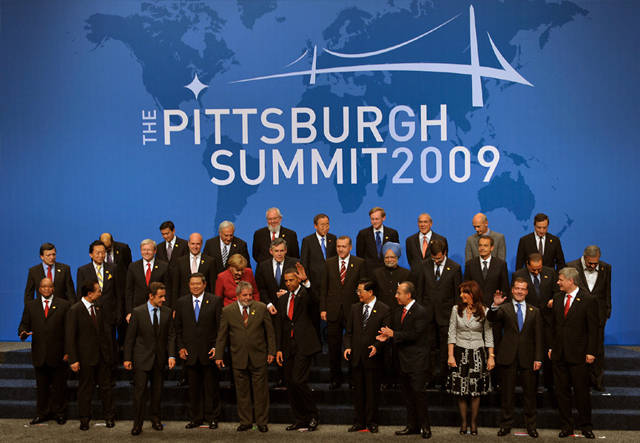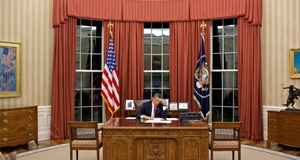From Cornell International Affairs Review VOL. 3 NO. 1The G-20 Preempts the G-8: What Kind of World Economic Order?
KEYWORDS:
Few would disagree that the most significant development at the G-20 meeting in Pittsburgh during September 24-25, 2009 was the formal acknowledgement of the changing of the guards. In the draft communiqué, President Barack Obama declared that from now on, the Group of 20 (G-20) will be the primary organization responsible for coordinating global economic policy. The British Prime Minister Gordon Brown was more explicit, noting that “the old system of international economic cooperation is over. The new system, as of today, has begun... The G-20 is now the premier economic organization for dealing with economic management around the world.” The G-20 now takes over the responsibilities and challenges that had been for decades the purview of an elite club made up of the world’s wealthiest countries–the G-7, and more recently, the G-8. It has been a meteoric rise for an organization hastily put together only in 1998 and formally established in 1999 to ostensibly break the glass ceiling at the exclusive G-7– or, according to the official line, to bring together “systemically important industrialized and developing economies” to discuss key issues in the global economy. Ironically, it was the financial crises of the late 1990s (in Asia, Argentina, and Russia, among others) that led to the creation of the G-20. These crises, in particular, the dysfunctional, often half-hearted response by the powerful G-7 economies and financial institutions like the International Monetary Fund (IMF) and the World Bank, led emerging economies like China, India, Russia, Brazil (the so-called BRIC countries), among others, to demand a more fair and balanced representation in global organizations. It was the perfect storm unleashed by the financial crisis of 2008 that finally shattered the glass ceiling. For the secretive, yet increasingly weary and flabby G-8, economic reality and prudence dictated that it was time to acquiesce and make space at the table for the new and emerging titans and players of consequence in the world economy –the Chinas, the Indias and the Brazils. At the G-20’s inaugural meeting, this expedient group of old and new, including Argentina, Australia, Brazil, Canada, China, the European Union, France, Germany, India, Indonesia, Italy, Japan, Mexico, Russia, Saudi Arabia, South Africa, South Korea, Turkey, United Kingdom and the United States, with simultaneously clashing and converging interests, pledged to work together to resolve common challenges. No doubt, the G-20, which includes countries from all regions of the world and together constitutes some 90 percent of global gross national product, 80 percent of world trade, and over two-thirds of the world’s population, is a far more representative body. Yet, before Pittsburgh, the conventional view was that the G-20’s broad membership was a mere front (“G-8 plus 12” was what the G-20 was disparagingly called), designed to give the organization greater legitimacy, while real power and influence still resided with the “old boys” in the G-8. However, the unprecedented subprime-induced financial crisis, which was triggered in the United States and has wrecked havoc in the G-8 countries, seems to have finally forced the recognition of a new global reality: that the G-20 countries, especially economic behemoths like China and fast growing economies like India, now have the wherewithal to play an important role in mitigating the global financial crisis. In fact, the important contributions made by China and other emerging economies in averting a global economic disaster by implementing aggressive stimulus programs in concert with the United States and Western Europe were hardly lost to the old boys. Arguably, as this reality began to sink in, the United States and the other G-8 members reluctantly agreed to make the G-20 the new global economic coordinator and chief architect in creating the so-called “new global financial architecture.” At its April 2008 meeting, the G-20 was upgraded from a ministerial to a more powerful leaderslevel forum. The G-20 had finally arrived. Although history may very well remember that the main achievement of the Pittsburgh gathering was the institutionalization of the G-20 as the world’s premier economic body, President Obama, breaking subtly with protocol, declared the Pittsburgh summit a success on the first day after another dramatic breakthrough. In an unexpected move, the G-20 agreed to make the IMF more representative by increasing the voting power of countries which have long been under-represented in this premier financial organization during the IMF’s next quota review due in January 2011, with similar reforms endorsed for the World Bank. “The G-20 is now the premier economic organization for dealing with economic management around the world.” Specifically, the advanced economies led by the United States agreed to shift the IMF’s voting power by at least 5 percent. Although this is a modest reweighting, it nevertheless means that the current split in voting power (which is 57 percent for industrialized countries and 43 percent for developing countries), will now become more balanced – albeit, not entirely equal. The fact that Britain and France (who will see the biggest dilution in their voting power), and who have long resisted this reform, agreed to the voting shift without delay and with unanimity underscored their recognition of the new global economic reality, and the fact that China, India, Brazil and Russia, among the other G-20 members, had made clear that their cooperation on pressing global economic issues was contingent on meaningful reforms in the IMF (especially changes to the skewed voting system) and other global bodies. Indeed, the Brazilian Finance Minister Guido Mantega had drawn a line in the sand by demanding in April 2009 that the IMF’s “democratic deficit” had to be corrected quickly. Although the BRIC countries had demanded a 7 percent shift in voting power, they apparently settled for 5 percent. This does not mean that all the emerging economies will receive a quota increase. Rather, China, which is most underrepresented (with only a 3.7 percent voting share on IMF executive board decisions) will see its share rise sharply, while Britain and France, including Saudi Arabia, the most overrepresented country (with a 3.2 percent voting share) will see their shares decline. Since this change will come at the expense of the Europeans without affecting the United States (which will continue to maintain its voting and veto powers ), and given the IMF’s opaque voting formula and machinations within the executive board, implementing this change will neither be easy nor pleasant. It is important to note that earlier proposals regarding changes in the voting formula at the IMF (and the World Bank) have gone nowhere and there is no guarantee that the G-20 members will be able to bridge the long-standing disagreements over how much power the wealthy nations should cede to major developing countries. Compounding this challenge is the fact that some of these proposed changes are subject to approval by the legislatures of some member countries – meaning that legislatures may not approve what their executives agreed to in Pittsburgh. For example, the United States has a 17 percent voting share in an organization that requires 85 percent majority for all major decisions, which means that the U.S. Congress can veto any changes it does not like – and it does not like many. Nevertheless, the IMF’s new voting order proposal, which more fairly reflects the relative weights of its 186 member countries in the world economy, is long overdue, not only for the sake of fairness, but that a more representative and accountable governance structure is essential to strengthening the IMF as a global organization. For example, recognizing China’s new economic clout and giving it greater say within the IMF has the potential to make China a less adversarial and more responsible stakeholder, besides providing further momentum to the 2011 deadline for overhauling IMF governance. Since the G-20 also agreed in principle that the head of the IMF should be selected based on “qualifications and not nationality,” it means that the traditional practice under which the head of the IMF was a European and the president of the World Bank an American, may soon become another quintessential relic of an earlier economic order. After such a momentous development, the remainder of the meeting tackled boilerplate issues that all stakeholders could agree with – at least on paper. For example, all the G-20 member countries agreed to subject their domestic economic policies to the scrutiny of a peer review process in order to determine whether they were “collectively consistent” with internationally agreed regulations by 2010. Although the IMF has been designated as supervising this process, the reality is that the plan lacks an enforcement mechanism to enable the IMF do perform its duties, including the basic task of correcting global imbalances. More specifically, although the G-20 stressed the importance of balanced growth by emphasizing the need to avoid the “reemergence of unsustainable global financial flows,” how this was to be achieved was not spelled out. In other words, how can a balance be achieved between countries like the United States and Britain which chronically run large dollar current-account deficits and others, most notably, China, Japan and Germany, which persistently run-up large surpluses? It is now widely acknowledged that these large dollar surpluses were not only partly responsible for the asset bubbles that underlie the current financial crisis; these imbalances have also left the deficit countries globally uncompetitive, especially in manufacturing industries. Unfortunately, the G-20 could only agree on the principle that both too much saving and too much spending were equally destabilizing. Clearly, coordinated action by the G-20 on this critical issue is unlikely. Similarly, while each member country also committed to a more coordinated financial regulation and to expeditiously clamp-down on bankers pay schemes by linking pay to “long-term value creation, not excessive risk-taking,” again, the details regarding implementation were missing. The suggestion that supervision of salary and bonuses would be carried out by each country, while the Financial Stability Board (a group made-up of finance ministers and central bankers) will only broadly monitor implementation, raised more questions about the G-20 seriousness on this critical matter. Equally troubling, details regarding how derivatives such as credit default swaps (responsible for the credit crisis) were to be regulated were missing. At the insistence of the United States, the G-20 members agreed to require their banks and other financial institutions to have “higher levels of capital reserves” as a buffer against unexpected losses or disruptions in credit markets – albeit how “high” these capital reserve levels were to be was not specified. Instead, the levels were to be developed by each country by the end of 2010 --with the aim of putting them in place by the end of 2012. The EU, which has long claimed that increasing capital requirements would put their banks and financial institutions at a competitive disadvantage because they have traditionally maintained smaller reserves, clearly got its way on this issue. Regarding trade, the G-20 members made a commitment to “reject protectionism in all its forms” and pledged to work diligently to conclude the never-ending Doha Round of trade talks. However, missing were the details as to how they planned to avoid protectionism – especially, the “creeping protectionism” in the United States and the EU. Clearly, for highly export-dependent economies like China this is a major concern. In fact, in an apparent reference to a recent trade dispute in which the United States imposed punitive tariffs on Chinese tire imports, President Hu Jintao politely rebuked the G-20 leaders to “resolutely oppose and reject protectionism in all forms.” For its part, apparently glowing in its newfound status as a global economic trendsetter, Beijing reiterated its commitment to rebalancing the world economy by “strengthening domestic sources of growth” – or more bluntly, by consuming and importing more. The fact that China promised to further boost domestic demand (in addition to the $600 billion it has already spent to stimulate its economy and make it less dependent on exports), signals the arrival of China as the new global economic powerhouse. Yet, the G-20 could have done more. In particular, it should have impressed upon China, which is quite understandably concerned about a “collapse” of the U.S. dollar and the losses this would entail on its massive $2 trillion of foreign-exchange reserves, to fix its irredentist exchange-rate system if it is to solve its currency problems. Although China reiterated its commitment at the G-20 to move to a more flexible exchange rate (because an appreciation of the yuan in effective terms would help promote more balanced growth in China and in the world economy), the fact is that China has kept its currency essentially flat against the dollar since the global financial crisis erupted in mid-2008. In addition, a number of other contentious issues remain on the table. For example, although the G-20 leaders unanimously endorsed an agreement regarding the phasing out of subsidies for fossil fuels and coal to help combat global warming by reducing greenhouse gas emissions, they did not provide any details as to the permissible levels or set a fixed timetable when the reductions were to take effect. Countries such as China, India and Russia, which provide generous tax breaks and direct payments and subsidies to their energy companies (both government owned and private), have long argued against the equivalence between them and the advanced economies, including that they undertake binding mitigation commitments. This is because, although the United States, China and India are among the world’s three largest carbon emitters in absolute terms, when population and percapita income are factored in, the latter two rank quite low. Based on this, China and India claim that if they were to agree to cap their emissions at current levels, their growth would be gravely undermined.Continued on Next Page » Suggested Reading from Inquiries Journal
Inquiries Journal provides undergraduate and graduate students around the world a platform for the wide dissemination of academic work over a range of core disciplines. Representing the work of students from hundreds of institutions around the globe, Inquiries Journal's large database of academic articles is completely free. Learn more | Blog | Submit Latest in Economics |





















